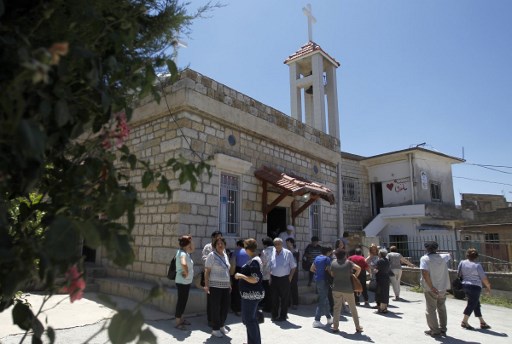Golan- The small church in the village of Ein Qiniye in the Israeli-occupied Golan Heights opens only on rare occasions.
Few Christians remain on the Israeli-held part of the strategic plateau northeast of the Sea of Galilee.
Israel seized 1,200 square kilometers of the Golan from Syria in the Six-Day War of 1967 and later annexed it in a move never recognized by the international community.
Before the occupation, Christians accounted for 12 percent of the population of the Golan, which then had 340 villages and 150,000 inhabitants, researcher Salmane Fakhreddine tells Agence France Presse.
Today, about 22,000 Syrian Druze live on the Israeli-controlled side of the Heights as well as 25,000 Israeli settlers who moved in after 1967.
Only two isolated Christian families still live there.
Without the perseverance of the Adibs, the last Christian family left in Ein Qiniye, the Maronite church perched on hills overlooking the Sea of Galilee would have faded into oblivion.
Before 1967, says Assaf Adib, 57, about 600 Christians and 300 Druze lived in the village but with the outbreak of war most of the Christians fled westward to the disputed Shebaa Farms area along the Lebanon-Israel ceasefire line.
Some of his close relatives moved a short distance north to the Golan Druze town of Majdal Shams, Adib said.
“My father and my uncle followed the Druze families and went to take refuge in Majdal Shams.”
They were allowed to return to Ein Qiniye with the Druze after the war but the other Christians were unable to get back home and were left in Syria or Lebanon.
Suriya Samaane, 72, is a member of an Israeli Christian support group from the Galilee which makes occasional solidarity visits to keep the little hilltop church going.
“We come from Nazareth to support the Christian presence in Ein Qiniye,” she told AFP outside the building after attending mass.
In Majdal Shams, Orthodox Christian Ibrahim Nasrallah, 80, recalls the time before the war, when “no one spoke of Christian, Muslim or Druze: we were all Arabs first and then Syrians,” he told AFP. “Thirdly we were Christians.”
“Before 1967 Christians left Majdal Shams to work in Quneitra,” he said, referring to the nearby once-prosperous provincial capital in southern Syria now torn apart by the civil war there.
“The most educated went to Damascus,” Nasrallah said, adding that two of his children have resettled inside Syria but he will remain where he is.
“Outside Majdal Shams I am like a fish out of water. I will not leave until I die.”
In Majdal Shams, the only church is closed.
“When my father died the priest had to come to our house to perform the funeral mass,” Nasrallah said.
He was then laid to rest in a cemetery shared by Druze and Christians among pine trees.
“In 1984 when we had my son Iyass baptized we got the Israeli authorities to open the Banias church,” south of Majdal Shams, Nasrallah added.
